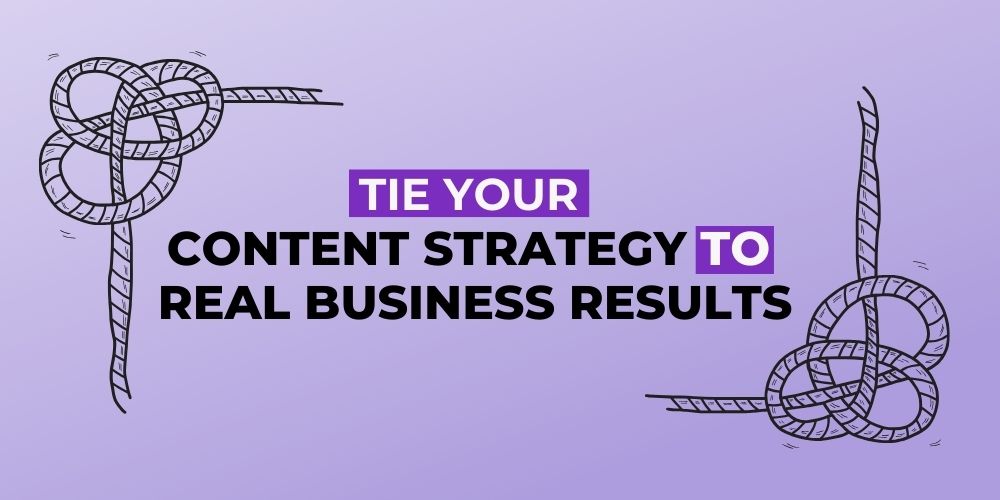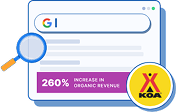You’re pouring time, creativity, and budget into content, but is it paying off? For many businesses, the answer is frustratingly unclear. While content marketing is hailed as a long-term growth engine, measuring the ROI of content marketing often feels like chasing smoke. You’re told to track clicks, views, and likes, but what about revenue? Conversions? Real results?
That’s exactly what we’re unpacking here. We’ll show you how to calculate the ROI of content marketing, pinpoint what metrics truly matter, and choose tools that bring clarity (not confusion).
You’ll walk away with a framework to turn content from a cost center into a revenue driver, and finally answer the question of whether you’re a startup founder, marketing lead, or content strategist. What is the ROI of content marketing… really?
What Is Content Marketing ROI?
At its core, the ROI of content marketing is a metric that helps you determine whether your content efforts are truly paying off. It tells you how much revenue your content is generating compared to the cost of creating and distributing it.
In simple terms, it’s like asking: “For every dollar I put into content, how much am I getting back?” Think of it as your content’s return ticket, what kind of value are you getting in exchange for all the time, effort, and budget spent on writing, designing, publishing, and promoting your content?

Let’s say you spent $1,000 creating and promoting a blog post, and it led to $4,000 in revenue. Your content marketing ROI would be 300%. That sounds amazing, right? But here’s where it gets tricky: what exactly counts as “return”? It’s not always as straightforward as direct sales. Sometimes the value lies in brand awareness, email signups, lead nurturing, or long-term customer retention, all of which can contribute to ROI in less obvious ways.
Measuring content marketing ROI isn’t just about plugging numbers into a formula. It’s about understanding what success looks like for your business and identifying which outcomes are worth tracking.
How to Calculate ROI for Content Marketing
The basic formula for calculating ROI is simple, but applying this in the real world is rarely straightforward. Content marketing doesn’t always produce immediate or easily traceable results, which makes accurate ROI measurement a bit more complex.
To get a realistic picture of your content marketing ROI, you need to consider two major elements:
1. Total Investment
This goes beyond just the cost of writing an article. You need to factor in:
- Content Generation: Graphic design, writer fees, and video production
- Tools and software: CMS, SEO tools, analytics platforms
- Distribution and promotion: Paid ads, email marketing, influencer collaborations
- Time and resources: Team hours, freelance costs, overheads
2. Return on Content
This refers to the measurable outcomes generated by your content:
- Leads generated
- Conversions and sales
- Email sign-ups or app downloads
- Customer retention or upsells
Anything that directly contributes to revenue or long-term customer value counts here.
Let’s Break It Down with an Example:
You invest $5,000 in blog content over three months. That content drives 100 qualified leads. If 10 of those leads convert into paying customers, each bringing in $1,000, your total return is $10,000.
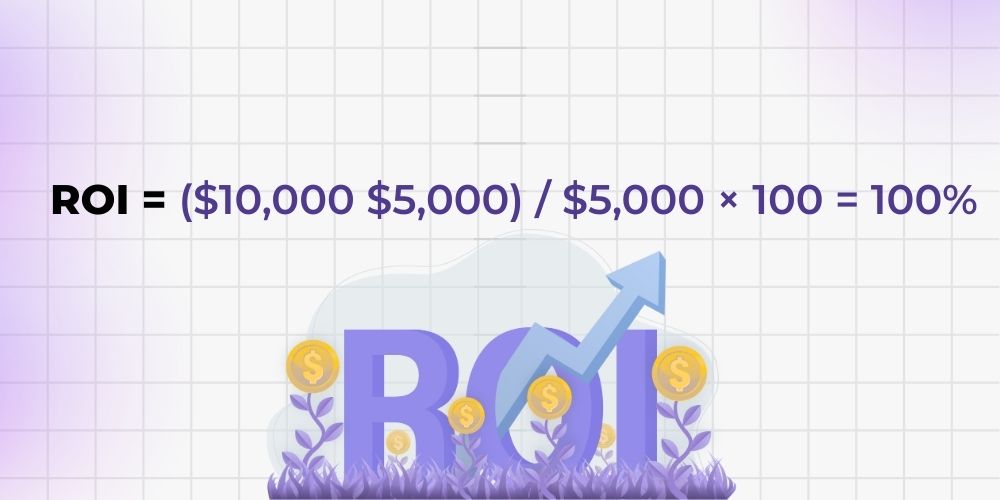
Now, plug that into the formula: Not bad! You’ve doubled your investment.
But here’s where most marketers get stuck: content marketing has a longer sales cycle. Some blog posts generate leads months after publication, and not all content is designed to convert directly. Plus, brand awareness and engagement, while valuable, are harder to quantify in dollar terms.
Why ROI Is Hard to Track
Because customer journeys aren’t linear anymore. Your blog might bring someone in today. They might sign up for your newsletter in a week. A month later, they read a case study. And then they buy.
Attribution gets muddy, and that’s why measuring the ROI of content marketing is more about layering insights than finding a silver bullet. It’s not about one metric, it’s about the full picture.
That’s why brands like The Meta Future focus not just on revenue, but also micro-conversions: form fills, ebook downloads, scroll depth, time on page. These give direction, even when the final conversion happens down the road.
Key Metrics to Measure Content Performance
So, how do we start painting a clear picture of how well your content is performing? You start by tracking the right metrics, the ones that actually tell you if your content is doing what it’s supposed to do: attract, engage, and convert.
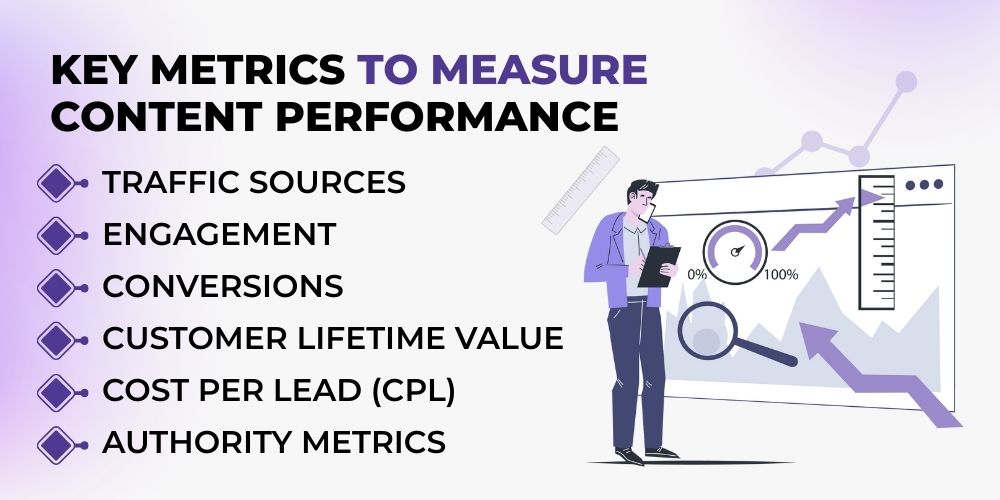
Here are some of the most essential metrics to measure content performance effectively:
1. Traffic Sources
Where is your audience coming from?
Break down your content traffic by source:
- Organic (via search engines),
- Direct (typed in URL or bookmarks),
- Referral (from other websites), and
- Social (Facebook, LinkedIn, etc.).
Knowing this helps you identify which channels are driving the most valuable traffic and where to double down. For example, if organic traffic is strong, your SEO efforts are paying off.
If referral traffic is low, you may want to boost outreach or backlink strategies.
2. Engagement
How are users interacting with your content?
Key engagement metrics include:
- Bounce rate (percentage of visitors who leave after one page),
- Time on page (how long users stay),
- Scroll depth (how far users scroll),
- Social shares (how often content is shared).
These indicators tell you whether your content is holding attention or pushing users away. High engagement typically signals relevance and quality, while low engagement could indicate a mismatch between audience expectations and your content.
3. Conversions
Is your content driving action?
Track specific conversion goals tied to your content, such as:
- Email signups,
- Ebook or whitepaper downloads,
- Product demo requests, or
- Contact form submissions.
When possible, connect these conversions to revenue, either directly or through attribution modeling. This is where content begins to prove its business value, not just its ability to generate traffic, but to generate leads and sales.
4. Customer Lifetime Value (CLTV)
What is a lead worth to your business over time? If your content is bringing in customers, you need to understand how much value each of those customers represents in the long run. CLTV helps you:
- Estimate potential revenue per customer,
- Justify long-term investment in high-quality content,
- Balance customer acquisition costs (CAC) against return.
Knowing CLTV allows you to look beyond the initial conversion and see the real business impact of your content marketing strategy.
5. Cost per Lead (CPL)
How much are you spending to get a lead? This metric is calculated by dividing your total content marketing spend by the number of leads generated. For example: CPL = Total Content Marketing Cost ÷ Total Leads Generated
A lower CPL suggests higher content efficiency. If your CPL is too high, it may signal the need to optimize content, better target audiences, or improve your distribution strategy.
6. Authority Metrics
How is your content contributing to your brand’s credibility and online presence? Authority-related metrics help measure trust, expertise, and visibility in your niche. These include:
- Backlinks (how many and from where),
- Domain rating or domain authority,
- Mentions and citations across the web.
Consistent growth in these areas shows your content is being recognized and referenced, which not only boosts SEO but also strengthens your brand’s thought leadership position.
Understanding KPIs That Matter
Not all KPIs are created equal, and not all of them truly reflect content marketing success. It’s easy to get distracted by surface-level metrics. Web traffic, for instance, might look impressive on a dashboard, but if it’s not driving action or engagement, it’s just vanity. What you really need are performance indicators that tie back to your core business objectives.
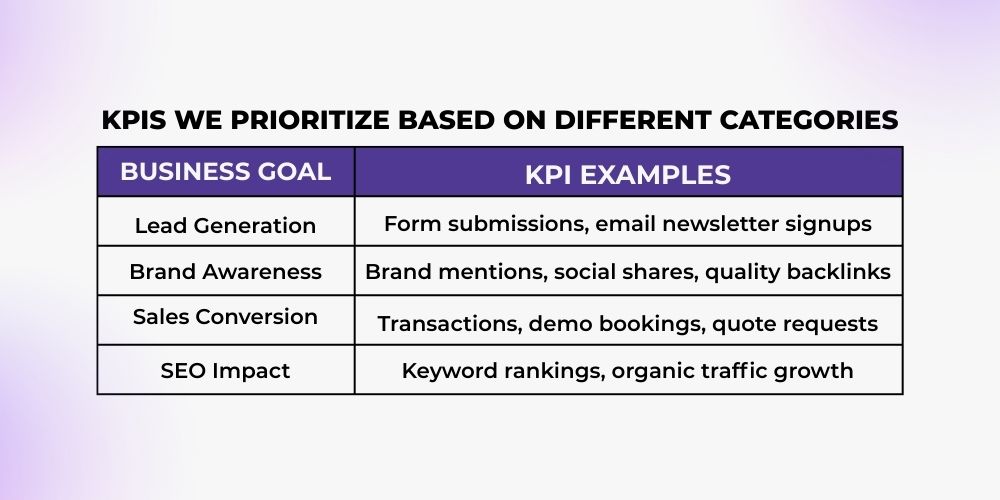
Our team at The Meta Future works closely with clients to identify KPIs that genuinely move the needle. These indicators go beyond basic analytics, they’re tied to specific goals in the customer journey.
These KPIs provide a more focused and actionable view of your content marketing performance. When aligned with your strategy, they help you make smarter decisions about where to invest your efforts and budget.
Pro Tip:
Develop a KPI scoring system. Assign a value or weight to each KPI based on how much it contributes to your overall funnel.
For example, a demo booking might carry more weight than a social share. This not only helps in tracking performance over time but also enables better forecasting and resource allocation.
Choosing the Right Tools for Tracking
You can’t measure what you don’t track, and when it comes to content marketing ROI, the right tools are not just helpful, they’re essential. These tools go beyond basic numbers; they help you uncover patterns, understand user behavior, and connect the dots between your content and actual business outcomes.
Here are some tried-and-tested tools we trust and recommend, along with why they matter:
1. Google Analytics
Still considered the gold standard for web analytics, Google Analytics offers a deep dive into how users interact with your content. You can track:
- Page Value: Understand which content pieces contribute most to conversions.
- Assisted Conversions: See how often content plays a supporting role in conversions.
- Time to Purchase: Analyze how long it takes a user to convert after engaging with content.
With proper goal-setting and conversion tracking, Google Analytics gives you a solid baseline to understand your content’s influence on ROI.
2. Semrush or Ahrefs
Both are powerful SEO suites that give visibility into your content’s organic performance. They allow you to:
- Track keyword rankings over time and measure content visibility.
- Monitor backlink growth, a strong indicator of authority and reach.
- Analyze competitor strategies, helping you benchmark content effectiveness.
By using these tools, you not only see how your content performs in search engines but also what’s driving traffic and where optimizations are needed.
3. HubSpot
If you’re running inbound marketing or lead-nurturing campaigns, HubSpot is your go-to. It excels at:
- Mapping content to various stages of the customer journey.
- Tracking how leads engage with content across email, blogs, and landing pages.
- Measuring content-assisted sales conversions and attributing ROI to specific touchpoints.
HubSpot’s integration capabilities also make it easy to tie marketing efforts to CRM data, giving you a more complete ROI picture.
4. Oribi
Oribi is an AI-driven analytics platform that simplifies tracking with minimal setup. Unlike more complex tools, Oribi is ideal for:
- Quickly identifying which pieces of content drive conversions.
- Automatically detecting high-impact user actions.
- Offering clear insights without needing a developer to configure events.
It’s especially useful for small teams or non-technical marketers who still want meaningful analytics.
5. Hotjar / Microsoft Clarity
Numbers tell you what’s happening, but visual behavior tools show you why. Tools like Hotjar and Clarity allow you to:
- Watch session recordings to see how users interact with your content.
- Analyze heatmaps and scroll depth to measure engagement.
- Identify drop-off points where readers lose interest or abandon the page.
These insights help you fine-tune content layout, improve UX, and retain attention longer, all of which support better ROI outcomes.
Pro Tip from The Meta Future: Combine tools for a holistic view.
Google Analytics gives you the raw data, traffic, bounce rates, and conversions. Semrush or Ahrefs gives you context, how you rank, how you’re found, and how you stack up against competitors. When layered, these tools provide clarity and confidence in your content decisions.
Conclusion
The ROI of content marketing isn’t a static number, it’s a living, evolving narrative. And like any compelling story, it needs context, strong characters (your audience), and a well-defined purpose.
Measuring ROI can feel overwhelming at times, especially with so many metrics and tools available. But the key is to simplify and focus on what truly drives results:
- What are you trying to achieve?
- Which metrics align with those specific goals?
- Are your tools offering insights you can actually act on?
We believe that great content deserves great outcomes. That’s why we, at The Meta Future, emphasize measuring smarter, not just harder. It’s not about drowning in data, it’s about identifying the signals that matter and using them to drive continuous improvement. Whether you’re just beginning your content marketing journey or fine-tuning a mature strategy, one truth holds firm: you can’t grow what you don’t measure. Start small, stay consistent, and let your data guide you toward meaningful results.

